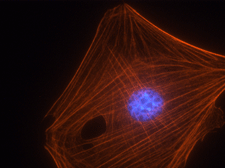Actin
Cytoskeleton provides a range of antibodies raised to actin binding proteins. For more information on each antibody please click on the Document tab above to see the datasheet.
In addition, Cytoskeleton has developed a unique line of fluorescent phalloidins with improved brightness and stability compared to other conjugates such as Alexa Fluor and Cy dyes. For more information see the Acti-stain information page.

Question 1: What is the best way to stain F-actin in cell and tissues?
Answer 1: Cytoskeleton offers our Acti-stain line of fluorescently-labeled phalloidins that specifically stain F-actin in fixed cell and tissue samples. The Acti-stain fluorescent phalloidin probes are very bright and stable and provide a very easy and economical way to label F-actin. Phalloidin is labeled with different green and red fluorophores (Cat. # PHDG1, PHDR1, PHDH1 and PHDN1).
Question 2: What dilution do you recommend for the polyclonal anti-actin antibody?
Answer 2: The dilution of antibody depends on the cell/tissue type and experimental format being used. For western blotting, we have tested and recommend using the antibody at a concentration of 500 ng/ml (1:1000 dilution). At this dilution, we detected actin in cell extracts of Xenopus A6 cells, mouse Swiss 3T3 cells, rat NRK cells, human HeLa cells, and platelet cells. For immunofluorescence, we used the anti-actin antibody to detect actin in mouse Swiss 3T3 cells. The antibody was used at a concentration of 2 μg/ml (1:500 dilution) followed by incubation with a 1:500 dilution of anti-rabbit rhodamine-conjugated secondary antibody. This information is found usually in the figure legends or within the “Product Uses” section of our antibody datasheets.
For more information, click on the Document tab above to see the datasheet.
- Anti-Pan Actin Mouse Monoclonal Antibody (Clone 7A8.2.1) AAN02Anti-pan actin: mouse monoclonal Learn More
-
